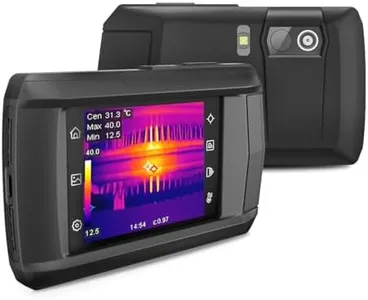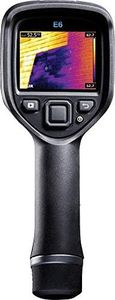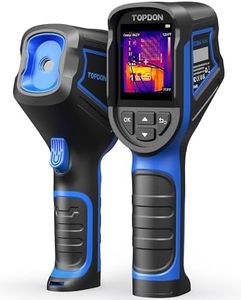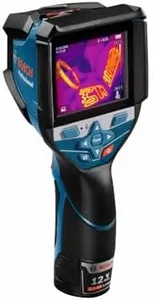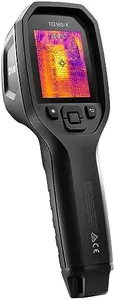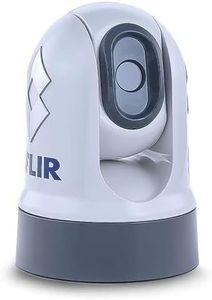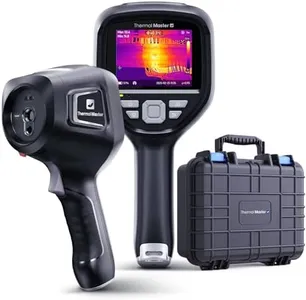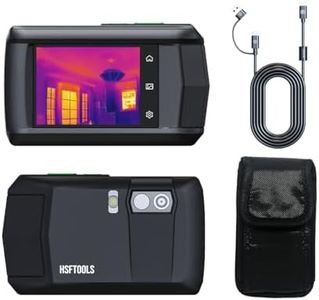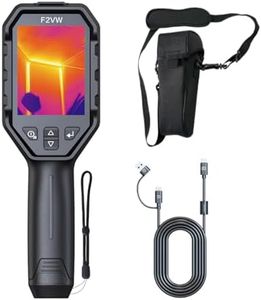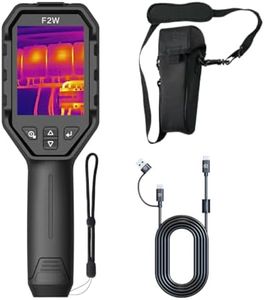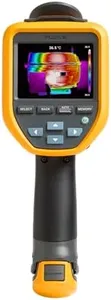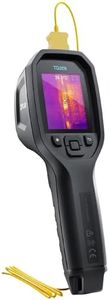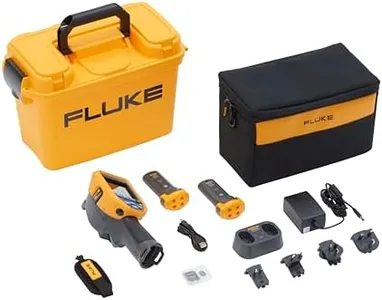10 Best Thermal Image Cameras 2025 in the United States
Our technology thoroughly searches through the online shopping world, reviewing hundreds of sites. We then process and analyze this information, updating in real-time to bring you the latest top-rated products. This way, you always get the best and most current options available.

Our Top Picks
Winner
FLIR E6-XT - Commercial Thermal Imaging Camera with WiFi. High Resolution Infrared Camera Ignite Cloud
Most important from
273 reviews
The FLIR E6-XT is a commercial thermal imaging camera designed for various applications like building, mechanical, and electrical inspections. It stands out with a high thermal resolution of 240 × 180 pixels, enhanced by FLIR's patented MSX technology. This tech overlays visual details on thermal images, making them clearer and easier to interpret. The temperature range it measures is quite broad, from -20°C to 550°C (-4°F to 1022°F), which makes it versatile for different environments and conditions.
FLIR products are known for good sensitivity in detecting minute temperature differences. On the connectivity front, the E6-XT includes WiFi, allowing images to be stored, edited, and shared via the FLIR Ignite Cloud. This feature, along with over-the-air updates, ensures the camera stays up-to-date with the latest improvements and saves users valuable time. Durability is another strong point, with an IP54 rating indicating good protection against dust and water, and the device's robust build quality.
Ergonomically, it is lightweight at 1.27 pounds and designed to be handheld, making it convenient for extended use. The display resolution is somewhat modest at 480p, which may not provide the sharpest detail for critical inspections. Additionally, while the battery is rechargeable and included, it's always worth considering the practical battery life during intensive use. The FLIR E6-XT is a capable and user-friendly thermal imaging camera with excellent connectivity and durability features.
Most important from
273 reviews
TOPDON TC004 Mini Handheld Thermal Imaging Camera, 240 x 240 TISR Resolution, -4°F to 842°F, 15-Hour Battery Life, 128 x 128 IR Resolution, 25Hz Infrared Camera, High/Low Temp Alerts, Auto Shutdown
Most important from
301 reviews
The TOPDON TC004 Mini is a compact thermal imaging camera designed for everyday use in home inspections, electrical work, and machinery checks. It starts with a 128x128 thermal sensor but enhances images to 240x240 resolution using TISR technology, offering clear and detailed thermal views. Its 40°x30° field of view is wide enough for scanning larger areas, and the 25Hz refresh rate ensures smooth real-time imaging. Temperature measurement covers a useful range from -4°F to 842°F, suitable for various tasks from checking heating systems to spotting overheating components. One handy feature is the automatic high/low temperature alerts, which notify you instantly and save a photo for easy troubleshooting. The camera supports multiple color palettes, letting you choose the visual style that best suits your preference or work conditions.
With a 15-hour battery life and automatic shutoff options, it’s built to last through long inspections without frequent recharging, though you’ll need your own charging adapter since only the cable is provided. Its lightweight, pocket-friendly design and ergonomic grip make it comfortable for extended use. The device is also durable, rated IP54 for splash resistance and can handle drops up to 2 meters, making it well-suited for fieldwork. Storage allows up to 8,000 photos internally, simplifying data management. However, it lacks advanced connectivity features like Wi-Fi or Bluetooth, so transferring images requires connecting the device physically.
The TOPDON TC004 Mini functions as a reliable, easy-to-use thermal camera for homeowners and professionals looking for a portable, durable tool to perform routine thermal inspections without complex setup or high-end features.
Most important from
301 reviews
Bosch GTC600C 12V Max Connected Thermal Camera
Most important from
12 reviews
The BOSCH GTC600C Professional Thermal Imaging Camera offers a range of features suitable for various applications in electrical, HVAC, and more. Its resolution of 256x192 provides detailed thermal images with over 49,000 measurement points, making it effective for detecting temperature anomalies. The camera's temperature range from -4°F to 1112°F (-20°C to 600°C) allows for usage in diverse conditions, making it highly versatile. With a sensitivity (NETD) conducive to precise detection, it swiftly identifies hot and cold spots.
The built-in microphone for voice notes is a convenient feature for on-the-job documentation, while WiFi connectivity ensures easy transfer of data via the Bosch ThermalOn App. The included 12V rechargeable battery offers a long runtime, and the IP54 rating certifies its durability against dust and rain, making it suitable for tough jobsite conditions.
The large screen and easy-to-read display enhance user experience, and the camera stores up to 500 images, providing ample storage for both thermal and visual pictures. The weight of 4 pounds might make it slightly cumbersome for prolonged usage. Despite these minor drawbacks, the BOSCH GTC600C is a robust and feature-rich thermal imaging camera suitable for professionals needing reliable and precise temperature detection and documentation.
